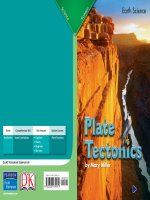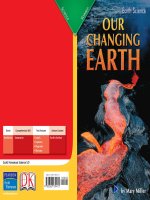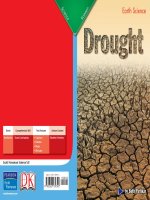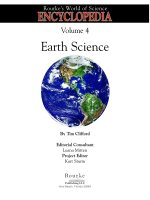4 7 severe storms (earth science)
Bạn đang xem bản rút gọn của tài liệu. Xem và tải ngay bản đầy đủ của tài liệu tại đây (2.96 MB, 10 trang )
Genre
Nonfiction
Comprehension Skill
Main Idea and Details •
•
•
•
Text Features
Maps
Diagrams
Text Boxes
Glossary
Science Content
Severe Storms
Scott Foresman Science 4.7
ISBN 0-328-13878-9
ì<(sk$m)=bdihie< +^-Ä-U-Ä-U
Vocabulary
hurricane
storm surge
tornado
tropical depression
tropical storm
vortex
What did you learn?
1. Where does a hurricane’s energy
come from?
2. What makes a hurricane an example
of a system?
3. What is the difference between a tornado
by Colin
Kong
watch and a tornado
warning?
Picture Credits
Every effort has been made to secure permission and provide appropriate credit for photographic material.
The publisher deeply regrets any omission and pledges to correct errors called to its attention in subsequent editions.
Photo locators denoted as follows: Top (T), Center (C), Bottom (B), Left (L), Right (R), Background (Bkgd).
Opener: Getty Images; 2 Steve Starr/Corbis; 3 NOAA/OSEI; 6 Getty Images; 7 Warren Faidley/Photolibrary/OSF Limited;
9 Jim Reed/Corbis; 10 Getty Images; 12 (BL) Ray Soto/Corbis, (TL) Robert Preston/Alamy Images; 13 ©David R. Frazier/
Photo Researchers, Inc.
Unless otherwise acknowledged, all photographs are the copyright © of Dorling Kindersley, a division of Pearson.
ISBN: 0-328-13878-9
Copyright © Pearson Education, Inc. All Rights Reserved. Printed in the United States of America.
This publication is protected by Copyright, and permission should be obtained from the publisher prior to any
prohibited reproduction, storage in a retrieval system, or transmission in any form by any means, electronic,
mechanical, photocopying, recording, or likewise. For information regarding permission(s), write to
Permissions Department, Scott Foresman, 1900 East Lake Avenue, Glenview, Illinois 60025.
3 4 5 6 7 8 9 10 V010 13 12 11 10 09 08 07 06 05
4.
Hurricanes are very
destructive, but they can also be helpful in
some ways. Explain some ways in which
hurricanes are harmful and some ways in
which hurricanes are helpful. Use examples
from the book to support your answer.
5.
Main Idea and Details Give the main
idea of how hurricanes are different from
tornadoes. Include supporting details.
NORTH CAROLINA
Hurricanes
A hurricane is a storm with
a lot of energy. This energy
comes from warm ocean water.
Hurricanes can be part of
a tropical storm system.
SOUTH
CAROLINA
GEORGIA
ATLANTIC
OCEAN
FLORIDA
Tropical Storms
Become Hurricanes
Some storms form in
areas near the equator. The
areas around the equator are
called the tropics. The storms
that form in these areas are
called tropical storms. When
tropical storms grow larger
and stronger, they can become
hurricanes. A hurricane is a
dangerous kind of storm that
has wind speeds of at least
119 kilometers per hour.
A hurricane is made up of
many groups of thunderstorms.
These thunderstorms wrap
around the center of
a hurricane.
2
This satellite map shows the path of Hurricane
Floyd along the East Coast of the United States.
In September 1999, there was a very strong hurricane.
This hurricane was originally a tropical storm in the
Atlantic Ocean. People named it Floyd. When the storm
grew more powerful, it became Hurricane Floyd.
Floyd moved across the ocean and crashed into the
Bahamas. Some reports from the Bahamas told of waves
that reached a height of fifty feet. Then the storm hit
North Carolina. It was here that it did the most damage.
Although Floyd became weaker as it moved across land,
its huge size was still a problem. The heavy rainfall from
the hurricane covered a greater area than usual for a
hurricane. It also lasted longer than expected.
Hurricane Floyd caused fifty-one deaths in North
Carolina. It destroyed seven thousand homes and damaged
thousands more. Rebuilding after Floyd was costly.
3
Thunderstorms develop over
warm areas of low pressure
near the ocean’s surface.
Winds blow faster and
begin to swirl, forming
a tropical depression.
Wind speed continues to increase.
Pressure at the ocean’s surface
drops, causing a tropical storm.
The winds reach 119 kilometers
per hour. The storm becomes
a fully developed hurricane.
How Tropical Storms Form
A Hurricane System
A tropical storm needs certain conditions in order
to form. It needs a lot of warm ocean water. An area of
low pressure at the ocean’s surface is also important.
Winds blow toward this area of low pressure. Then,
the ocean provides heat and water vapor. As warm and
moist air rises, water vapor condenses. Clouds form.
These clouds sometimes become thunderstorms.
Water vapor releases heat energy when it condenses.
This makes the air warmer, and the storms grow.
Warm air high above the ocean moves away from the
thunderstorms. A tropical depression occurs when
winds grow stronger and begin to swirl. If the winds
blow even faster, a tropical storm forms. Winds in a
tropical storm move faster than sixty-two kilometers
per hour.
Thunderstorms move toward the area of lowest
air pressure. More air moves out from the top of the
storm than moves in at the ocean’s surface. Air pressure
becomes lower. The winds at the ocean’s surface blow
faster toward the center of the storm. The tropical
storm turns into a hurricane when the winds reach
119 kilometers per hour.
Parts that work together form a system. The atmosphere
and the ocean, two systems of Earth, work together to
form a hurricane. Hurricanes form in the atmosphere,
but they get their energy from the ocean.
Hurricanes can affect many of Earth’s systems.
Their winds make large waves in the ocean. When they
are over land, hurricanes can uproot trees, destroy
houses, and change the shape of the coast.
4
5
The center spot of a
hurricane is the eye.
The entire hurricane
spins around it.
The Eye of the Hurricane
The center of a hurricane is called the eye. The eye
is about twenty to fifty kilometers wide. The winds in
the eye are not strong. The groups of thunderstorms
right around the eye have the strongest winds. They also
have very heavy rains. Winds on one side of the eye
blow in one direction. Winds on the other side of the
eye blow in the opposite direction.
People in the area under the hurricane’s eye may
think that the storm has passed. They will soon find
out that the second half of the hurricane is coming.
Hurricane Classification
Hurricanes are very powerful. Their strong winds can blow
down large trees, tear down houses, and pick up cars.
Hurricanes are categorized by their wind speed.
Scale
Description
Wind Speed
(kilometers per hour)
category 1
category 2
category 3
category 4
category 5
6
weak
moderate
strong
very strong
devastating
119 to 153
154 to 177
178 to 209
210 to 249
greater than 249
A storm surge crashes against a bridge.
Wind and Water in a Hurricane
A hurricane’s strong rains can cause problems.
If a hurricane moves slowly over land, that area will get
a lot of rainfall. The rain can flood roads and buildings.
It can make lakes and rivers overflow. Rain can also cause
mudslides. These floods and mudslides can cause deaths.
Winds of a hurricane can create large waves on the
ocean. A storm surge is an unusual rise in sea level
caused by the storm’s winds. A storm surge is dangerous
because the large amount of water can act as a bulldozer.
It can sweep everything away that is in its path. A surge
can even kill people.
Hurricanes are usually known as destroyers, but they
can be helpful in some ways as well. The rains fill up
lakes, rivers, and streams. They water plants and also
prevent wildfires because forests are no longer so dry.
7
Predicting Hurricanes
Today scientists called meteorologists have tools
that can track hurricanes. Instruments all over the world
collect data about hurricanes.
Far above Earth’s surface, satellites track a storm’s
size, location, and wind speed. Special planes fly into
hurricanes to gather data. Scientists then put the data
into a computer. The computer develops a model to
forecast the weather that the hurricane will cause.
A model represents a system or set of events. Models
help people study objects that are too big, too difficult
to predict, or too dangerous to study directly.
With a computer model, people can predict a
hurricane’s strength, direction, and speed. But even
with the help of the computer, scientists
still need to use their knowledge and
experience to make a forecast.
8
Hurricane models are very useful. They predict the
storm’s path and show the location of the hurricane.
The models also show where the storm is heading.
Teamwork of Scientists
It takes more than one scientist to predict and track
hurricanes. One group of scientists may focus only
on pressures in the atmosphere. A second group may
improve the computer models. Others may study water
temperatures and how they affect a hurricane’s movement.
Scientists from different parts of the world may work
together to improve forecasts.
Meteorologists use computers
to make forecasts about
hurricanes.
9
Tornadoes
A tornado is part of a strong
thunderstorm. Many tornadoes form
in the midwestern United States.
How Tornadoes Form
A funnel cloud is a rapidly spinning
column of air that comes out of a strong
thunderstorm. It turns into a tornado when
it touches the ground. Tornadoes usually
have winds that are less than two hundred
kilometers per hour. Strong tornadoes can,
however, have winds that reach speeds of
five hundred kilometers per hour. These are
some of the fastest winds on Earth. Most
tornadoes develop in the spring and summer.
Tornadoes form when the inside of
a thunderstorm spins. Next, a narrower
column of air starts to spin even faster.
This column becomes a tornado when
it touches the ground. Sometimes
tornadoes can come from the groups
of thunderstorms in a hurricane.
10
The Vortex
A vortex is an
area where air or liquid
spins in a spiral or circular
motion. When you drain a full
bathtub, you can see a small vortex
of water. A tornado is a vortex formed
in a thunderstorm. The outside of the
tornado has air swirling upward.
There is very low air pressure at the
center of a tornado. Air rushes into this
low pressure area. Water vapor condenses
along the outside of the tornado. Then, a funnel
cloud may form below the base of the storm.
The funnel cloud gathers dust and almost any
object in its way. All this material may make it
easier to see the vortex. But if there are heavy
rains, large dust clouds, or darkness, people
may still be unable to see the tornado.
The vortex forms a funnel
that narrows as it nears
the ground.
11
Dust Devil
Tornado Forecasts
A dust devil is not a
tornado. It is not even
part of a thunderstorm.
It is a column of swirling air.
It can form on a clear day.
A dust devil has much
slower winds than a tornado
has. Its winds are approximately
ninety-five kilometers per
hour. Dust devils are most
often found in deserts.
Warm, moist air masses collide with cold air masses
to form strong thunderstorms. Only some strong
thunderstorms become tornadoes. It is difficult
to predict a tornado. Tornadoes form and
move very quickly. There is not always
much time to warn people about them.
Tornadoes usually destroy
everything in their path. Scientists
who study tornadoes take great
risks to get close to tornadoes
and learn more about them.
Doppler radar is an instrument
that identifies the direction and
speed of wind. It also tells scientists
about the vortex of a tornado.
Waterspout
A waterspout is a rapidly
spinning column of air.
It forms over a lake or ocean.
Its vortex lifts water droplets
from the body of water
it is over. Waterspouts
are connected to clouds.
A waterspout can be a
tornado that has just moved
from the land to the water.
Waterspouts are often not
as strong as tornadoes.
12
Doppler radar tower
Tornado Classification
Scientist T. Theodore Fujita developed a scale to classify
tornadoes. The scale measures the wind speed of a tornado
and the amount of damage caused by strong winds.
Scale
Damage
Wind Speed
(kilometers per hour)
F0
F1
F2
F3
F4
F5
light
moderate
considerable
severe
devastating
incredible
64 to 116
117 to 180
181 to 253
254 to 332
333 to 419
420 to 512
13
Safety
Hurricanes and Tornadoes
The National Weather Service notifies people about
tornadoes. It sends out information on the radio and
television. A tornado watch means that a tornado is
likely to form within a few hours. A tornado warning
means that a person or a weather instrument has seen
a tornado.
It is very important to take cover when there
is a tornado warning in your area. Try to go
inside a building or take cover
in a basement. If there is no
basement in the building, go
into a small room such as a
bathroom, closet, or hallway.
If you are stuck outside, lie
flat in a low area with your
head covered. Do not stay
inside a car. A tornado
can move faster than
a car. It can even pick
up a car and throw it.
Hurricanes and tornadoes are very strong, dangerous
storms. Both storms spin around a center of low
air pressure. Their strong winds cause a lot of damage.
Tornadoes can cause
devastation. Listen to
advice on the radio and
television about how to
stay safe if a tornado strikes.
14
Hurricanes form over the sea.
When they move over land,
tornadoes can develop.
Hurricanes and tornadoes are also very different
in many ways. A hurricane is wider than a tornado.
It can be hundreds of kilometers wide, while a tornado
is usually not more than one hundred meters wide.
A hurricane contains many thunderstorms, while a
tornado comes from one thunderstorm. Hurricanes
form over water, while almost all tornadoes form over
land. A big difference between a hurricane and a tornado
is how long each storm lasts. A hurricane can last for
many days or even weeks. A tornado lasts for only
a few minutes, but a tornado’s winds can be much
stronger than a hurricane’s winds.
15
What did you learn?
Vocabulary
Glossary
hurricane
storm surge
hurricane
a dangerous storm with winds of
tornado
at least 119 kilometers per hour
tropical depression that is composed of many groups
tropical storm
of thunderstorms
vortex
storm surge
an unusual rise in sea level
caused by a storm’s winds
tornado
a rapidly spinning column of
air that comes down from a
thunderstorm and touches
the ground
tropical depression a storm with swirling winds
and rains that is stronger than
a disturbance but weaker than
a storm
Picture Credits
Every effort has been made to secure permission and provide appropriate credit for photographic material.
The publisher deeply regrets any omission and pledges to correct errors called to its attention in subsequent editions.
tropical storm
a storm that develops in the tropics
with wind speeds faster than
Opener: Getty Images; 2 Steve Starr/Corbis; 3 NOAA/OSEI; 6 Getty Images; 7 Warren Faidley/Photolibrary/OSF Limited;
9 Jim Reed/Corbis; 10 Getty Images; 12 (BL) Ray Soto/Corbis, (TL) Robert Preston/Alamy Images; 13 ©David R. Frazier/
sixty-two kilometers per hour
Photo Researchers, Inc.
Photo locators denoted as follows: Top (T), Center (C), Bottom (B), Left (L), Right (R), Background (Bkgd).
Unless otherwise acknowledged, all photographs are the copyright © of Dorling Kindersley, a division of Pearson.
vortex
an area where air or liquid spins
or swirls
ISBN: 0-328-13878-9
Copyright © Pearson Education, Inc. All Rights Reserved. Printed in the United States of America.
This publication is protected by Copyright, and permission should be obtained from the publisher prior to any
prohibited reproduction, storage in a retrieval system, or transmission in any form by any means, electronic,
mechanical, photocopying, recording, or likewise. For information regarding permission(s), write to
Permissions Department, Scott Foresman, 1900 East Lake Avenue, Glenview, Illinois 60025.
3 4 5 6 7 8 9 10 V010 13 12 11 10 09 08 07 06 05
16
1. Where does a hurricane’s energy
come from?
2. What makes a hurricane an example
of a system?
3. What is the difference between a tornado
watch and a tornado warning?
4.
Hurricanes are very
destructive, but they can also be helpful in
some ways. Explain some ways in which
hurricanes are harmful and some ways in
which hurricanes are helpful. Use examples
from the book to support your answer.
5.
Main Idea and Details Give the main
idea of how hurricanes are different from
tornadoes. Include supporting details.









